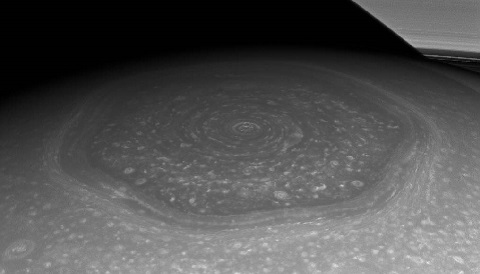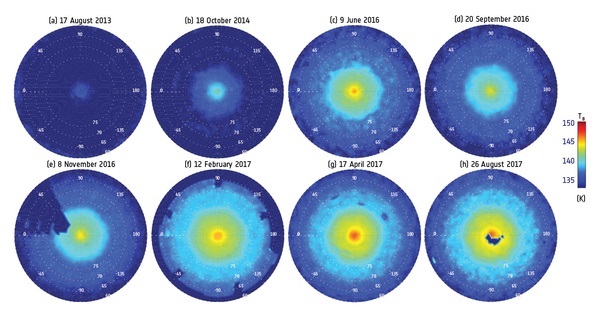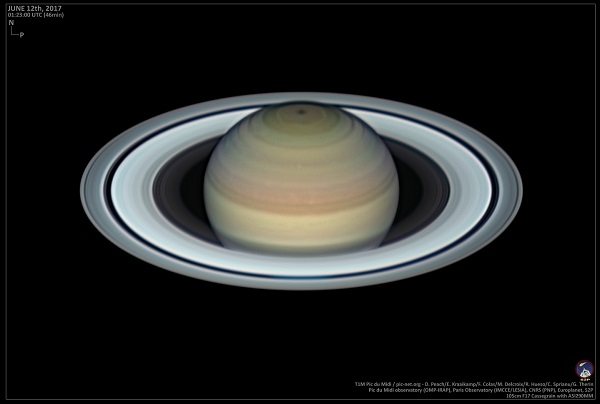Cassini's legacy sheds more light on the strange mystery of Saturn's northern polar hexagon.

NASA / JPL-Caltech / Space Science Institute.
One of the strangest features in the solar system is the hexagon adorning Saturn's polar region. First spied by the Voyager 1 spacecraft during its historic 1980 flyby, this feature is unique among the planets of the solar system.
Now, a new study published in Nature: Communications suggests that the hexagon — a pattern found in Saturn's troposphere — may influence the appearance of a similar structure in the stratosphere, more than 300 kilometers (200 miles) above it.

NASA/JPL-Caltech/Space Science Institute/Hampton University
The findings come from NASA's Cassini spacecraft, which arrived in orbit around Saturn in July 2004 and terminated its mission with a planned atmospheric entry and disposal a year ago this week on September 15, 2017. Scientists carried out key measurements using the spacecraft's Composite Infrared Spectrometer (CIRS) from 2014 onwards.
"While we did expect to see a vortex of some kind at Saturn's north pole as it grew warmer, its shape is really surprising,” says Leigh Fletcher (University of Leicester, UK) in a recent press release. “Either a hexagon has spawned spontaneously and identically at two different altitudes, or the hexagon is in fact a towering structure spanning a vertical range of several hundred kilometers.”
Seasons on Saturn
Saturn orbits the Sun once every 29.5 years, so its "seasons" are just over seven years long. Winter in the northern hemisphere ended in 2009, a year that marked both the vernal equinox and the start of Cassini's two -year-long equinox mission.
But Cassini's CIRS instrument needed (relatively) warmer temperatures to make stratospheric observations over the northern hexagon; at the close of winter, temps hovered near -158°C, 20° below what CIRS needs to make observations. The start of northern summer on Saturn offered a final chance for observations near the end of Cassini's mission.

NASA / JPL-Caltech / University of Leicester / GSFC / L.N. Fletcher et al. 2018
A New System Emerges
In 2014, as the northern hemisphere entered summer, Cassini began probing the pole's stratosphere. Researchers soon realized they were seeing the ragged edges of a stratospheric hexagon emerge, mirroring the now-familiar pattern below it in the troposphere. This unexpected finding is at odds with what researchers expected to find: on Earth or on Saturn, wind speeds change considerably higher up in the atmosphere, making the presence of long-lived cloud structures extending through several layers unlikely. A cloud structure like the northern polar hexagon should remain trapped in the lower troposphere.
So just how is the hexagon outline persisting higher up? One possible mechanism put forward by researchers is a phenomenon known as evanescence, where a decaying wave has just enough energy to persist into the upper atmosphere.
“We can use the background atmospheric conditions (specifically, gradients of temperatures and winds) to find out whether a wave is trapped, or whether it's free to propagate vertically,” says Fletcher. “As long as the two regions where the hexagon can propagate aren't too far apart, enough of the information from the troposphere could actually reach the stratosphere, which is why we see the hexagon at both heights.”
If the polar hexagon is evanescing from the troposphere to the stratosphere, that means this structure traverses hundreds of kilometers in height. But it's still unclear whether this is really the case: “The hexagon is probably continuous, from the troposphere to the stratosphere, but there is a portion of the atmosphere in between where CIRS is unable to provide direct evidence of the hexagon,” says Linda Spilker (NASA-JPL). “Future atmospheric modeling will be useful to help explain what is observed.”
There was no hexagon at the south pole, either at the cloud tops or above, when it was observed early in Cassini's mission during southern summer. The northern jet stream on Saturn (at 78°N latitude) seems to be more unstable than its southern counterpart, possibly contributing to its unique hexagonal appearance.
Observing the Northern Hexagon
Certainly, it's a bit frustrating that Cassini ended its exploration of Saturn right as things were getting interesting up north. But even with Cassini gone, future observations of this phenomenon will still be possible with Hubble and its upcoming infrared successor, the James Webb Space Telescope.

Damian Peach
The northern polar hexagon even turns up on modern day Earth-based astrophotos. Indeed, it's interesting to realize that no observations of Saturn noted the hexagon prior to its discovery in the 1970s, though such an observation would have been possible by edge-eyed observers using large optics. Saturn's rings — and the planet itself — tilt a maximum of 27° relative to our line of sight, alternating between each hemisphere once every 14 to 15 years. The rings were tipped at their widest last year in 2017 with the northern hemisphere visible, and they're headed back towards edge-on in 2025.
One thing's for certain: it will be a while before we return to Saturn, perhaps when/if the Titan helicopter explorer mission proceeds. But for now we can marvel at the fact that Cassini is still producing a treasure trove of fascinating science discoveries.
 6
6









Comments
Roger Venable
September 11, 2018 at 7:36 am
Have they measured a rotation rate of the hexagon? If so, how does it compare to the planet's rotation rates at equatorial and tropical latitudes?
You must be logged in to post a comment.
David DickinsonPost Author
September 11, 2018 at 2:40 pm
Hi Roger,
Good question, let me querry the researchers. I do know that the exact rotation rate of Saturn is still actually somewhat of a mystery.
- Dave Dickinson
You must be logged in to post a comment.
David DickinsonPost Author
September 12, 2018 at 10:42 am
From researcher Leigh Fletcher: "It (the polar hexagon) rotates very slowly to the west by 0.0129 ± 0.0020° per day. That’s a tiny westward speed of 0.036 m/s relative to our best estimate of Saturn’s rotation speed."
You must be logged in to post a comment.
nestor
September 19, 2018 at 4:48 pm
Hi, it´s amazing. Is there any reason to explain the, almost, perfect hexagon shape?
You must be logged in to post a comment.
David DickinsonPost Author
September 20, 2018 at 4:06 pm
It's still up for debate, though there are some ideas as to just how Saturn's hexagon came to be, mostly concerning the jetstream gradient at that particular latitude vs rotation. I do know that researchers have duplicated the hexagon in the lab: https://en.wikipedia.org/wiki/Saturn%27s_hexagon#Explanations_for_hexagon_shape
You must be logged in to post a comment.
AlbertCohen
November 17, 2018 at 10:44 am
Dear David,
Thank you for your nice report. For the moment, a few questions about Saturn's North Polar Hexagon have already answered recently by Rostami et al., 2017, ICARUS (https://doi.org/10.1016/j.icarus.2017.06.006). For example the questions about longevity of the hexagon, why there is not the same pattern on the south pole, its dynamics, the reasons of meandering hexagon's side in the lab experiments, the role of Saturn's North polar cyclone in the stability of the hexagon, etc.
You must be logged in to post a comment.
You must be logged in to post a comment.